A magnificent array of hawks graces the skies in Texas, adding to the state’s rich biodiversity. With a total of 14 hawk species, each possesses distinct characteristics and plays a vital role in the intricate balance of ecosystems.
From the agile Sharp-shinned Hawk to the impressive Red-tailed Hawk, Texas provides a diverse habitat for these avian predators.
As we delve into the profiles of these majestic birds, we unravel their unique lifestyles, from nesting behaviors to hunting strategies.
Join us on a journey through the expansive Texan skies, where the captivating world of 14 hawk species awaits exploration, offering a glimpse into the fascinating avian diversity thriving in the Lone Star State. Stay focused.
14 Hawks in Texas
Check out the diverse avian world with a glimpse into the lives of 14 hawk species; each possesses distinct characteristics and plays a vital role in the intricate balance of ecosystems.
Each species brings unique characteristics and behaviors, showcasing the fascinating tapestry of North American birds of prey.
1. Red-shouldered Hawk
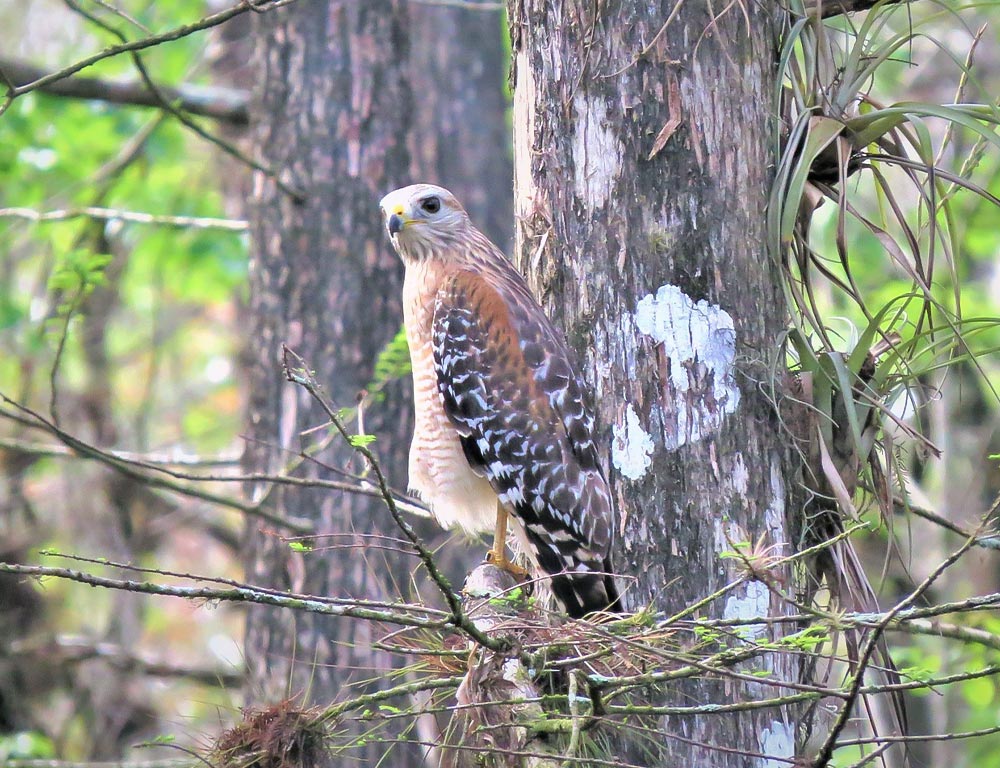
- Scientific name: Buteo lineatus
- Population: Common resident in Texas
- Life span: 10-15 years
- Size: 17-24 inches
- Weight: 1-2.5 pounds
- Food: Varied diet including small mammals, reptiles, and amphibians
- Wingspan: 37-43 inches
- Status: Secure
The Red-shouldered Hawk is a common resident of Texas, often found in forested areas near rivers and swamps. This medium-sized hawk is recognized by its distinctive reddish-brown shoulder patches.
Red-shouldered Hawks are territorial and often vocalize with a distinctive, piercing scream. They are skilled hunters, preying on small mammals, reptiles, and amphibians. Their broad wings and long tails allow for agile flight through dense vegetation.
These hawks typically build nests in tall trees, often near water sources. They are known for their monogamous behavior, with pairs forming long-term bonds. The Red-shouldered Hawk’s lifespan ranges from 10 to 15 years, and they play a vital role in controlling rodent populations in their habitats.
Protected under the Migratory Bird Treaty Act, Red-shouldered Hawks have a secure status. Conservation efforts focus on preserving their wooded habitats, as deforestation threatens their populations.
Their adaptability to diverse environments within Texas contributes to their overall resilience, but continued conservation efforts are essential to ensure their thriving presence in the state.
2. Sharp-shinned Hawk
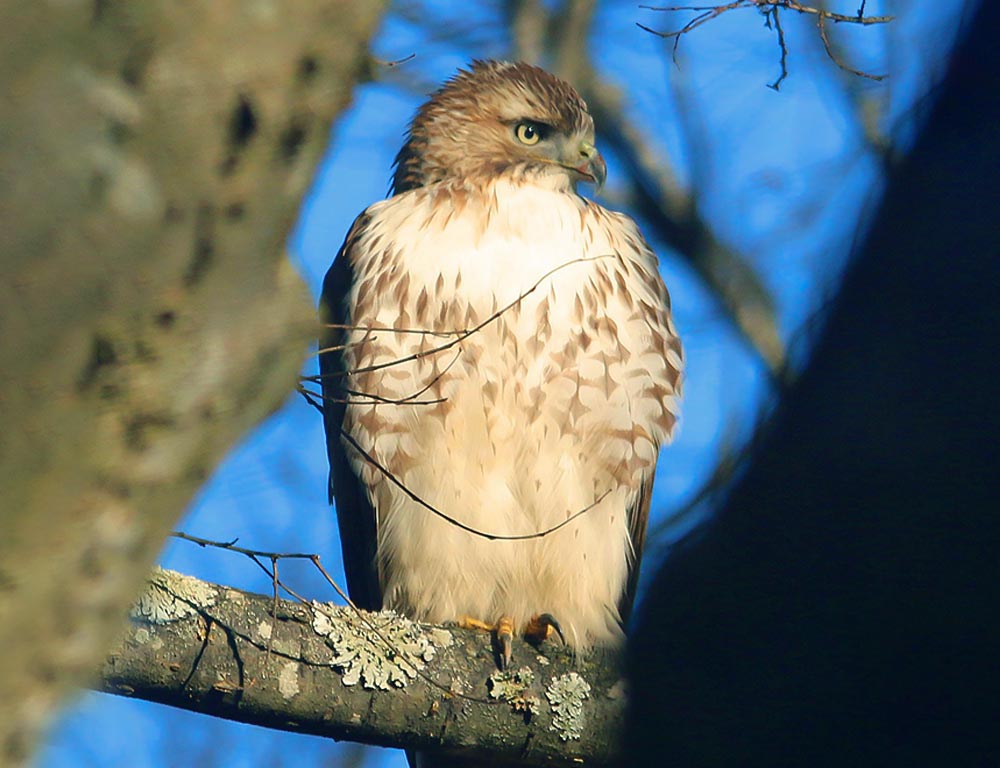
- Scientific name: Accipiter striatus
- Population: Common winter resident in Texas
- Life span: 7 years (average)
- Size: 9-13 inches
- Weight: 3-7 ounces
- Food: Small birds and mammals
- Wingspan: 16-22 inches
- Status: Secure
The Sharp-shinned Hawk is a common winter resident in Texas, migrating south to the state during the colder months. Recognized by its small size and short wings, this accipiter is a skillful predator of small birds and mammals.
Sharp-shinned Hawks are agile fliers, navigating through dense woodlands and urban areas in pursuit of their prey. With an average lifespan of 7 years, these hawks display sexual dimorphism, with females being larger than males.
They build nests in dense vegetation, utilizing twigs and sticks. During the breeding season, the males use impressive aerial displays to attract females.
Sharp-shinned Hawks play a crucial role in controlling populations of small birds and rodents, contributing to the ecological balance. Despite their secure status, they face habitat loss and pesticide exposure threats.
Conservation efforts focus on protecting their wintering habitats and raising awareness about the importance of these raptors in maintaining a healthy ecosystem.
3. Swainson’s Hawk
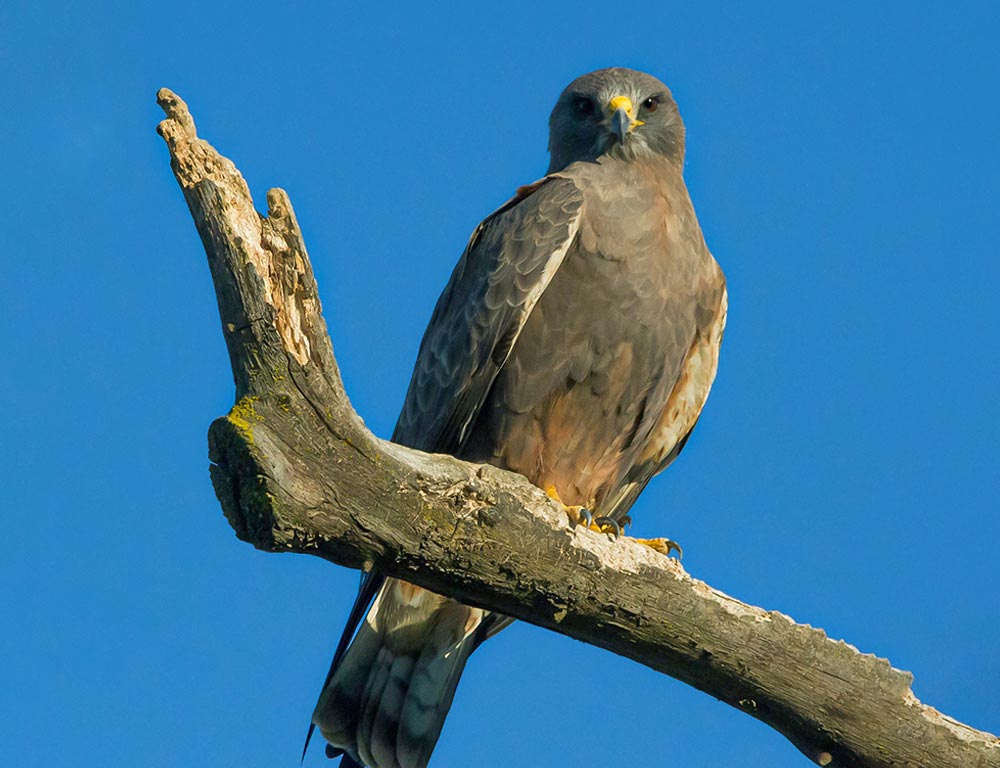
- Scientific name: Buteo swainsoni
- Population: Abundant during migration
- Life span: 10-15 years
- Size: 18-22 inches
- Weight: 1.5-2.5 pounds
- Food: Mainly insects, small mammals, and reptiles
- Wingspan: 45-55 inches
- Status: Secure
Swainson’s Hawks are known for their impressive long-distance migrations, making them abundant in Texas during their migration periods.
These hawks travel vast distances between their breeding grounds in North America and wintering grounds in South America. During migration, they often form large flocks known as “kettles.”
Characterized by a distinctive light underbelly and a dark bib-like marking on their throat, Swainson’s Hawks primarily feed on insects, small mammals, and reptiles. They are adaptable hunters, using their keen eyesight to spot prey from high altitudes before diving down to capture it.
Breeding pairs return to the same nesting site each year, constructing nests in trees or artificial structures like power poles. Swainson’s Hawks exhibit monogamous behavior during the breeding season.
With a lifespan of 10 to 15 years, these hawks contribute significantly to pest control, especially during their time spent in agricultural areas, where they help manage insect populations.
While Swainson’s Hawks have a secure status, threats include habitat loss, pesticide exposure, and collisions with power lines during migration.
Conservation efforts focus on protecting their nesting and wintering habitats and promoting sustainable agricultural practices.
4. Broad-winged Hawk
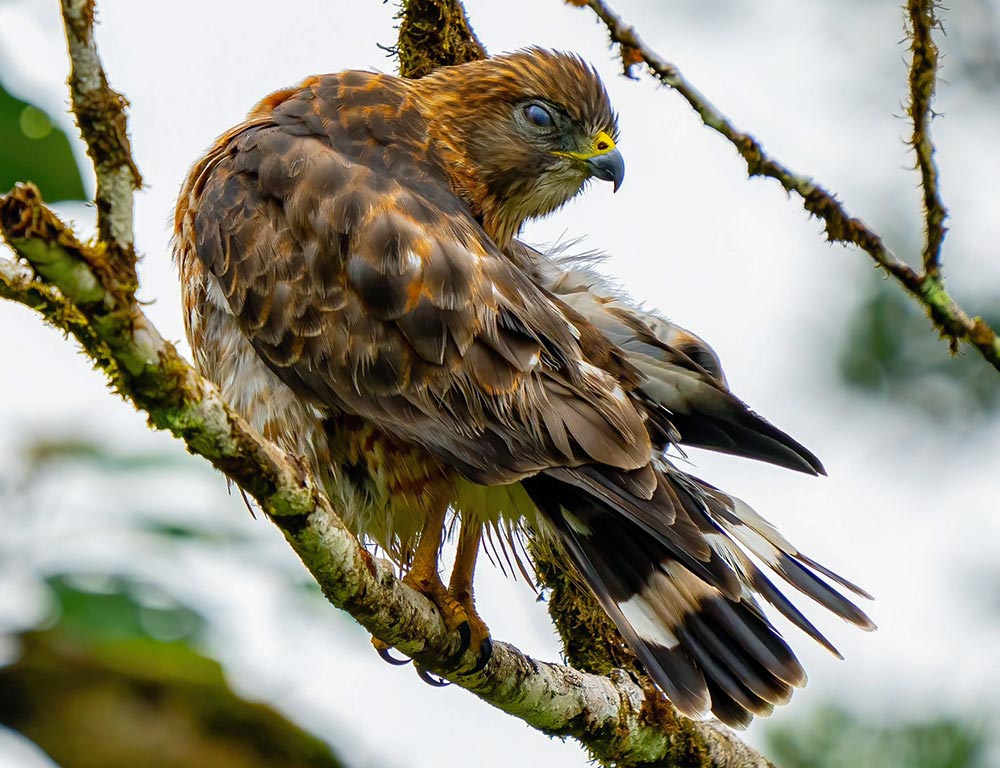
- Scientific name: Buteo platypterus
- Population: Common during migration
- Life span: 4-5 years
- Size: 13-17 inches
- Weight: 9-20 ounces
- Food: Small mammals, amphibians, reptiles, and insects
- Wingspan: 32-39 inches
- Status: Least Concern
Broad-winged Hawks are small to medium-sized raptors that are common during migration in Texas. Recognizable by their short, rounded wings and banded tail, these hawks undertake one of any North American raptor’s most remarkable migratory journeys.
During migration, they form large flocks or “kettles” and travel long distances between their breeding grounds in eastern North America and wintering areas in Central and South America.
Feeding primarily on small mammals, amphibians, reptiles, and insects, broad-winged hawks are adept hunters who use their keen vision to spot prey from elevated perches before making swift descents to capture it.
They build nests in deciduous trees, with both members of a breeding pair participating in the construction. With a 4 to 5 years lifespan, these hawks face threats such as habitat loss and climate change affecting their breeding and wintering grounds.
While currently classified as Least Concern, ongoing conservation efforts focus on monitoring their populations, preserving their migratory corridors, and raising awareness about the importance of maintaining healthy ecosystems for these remarkable birds.
5. Cooper’s Hawk
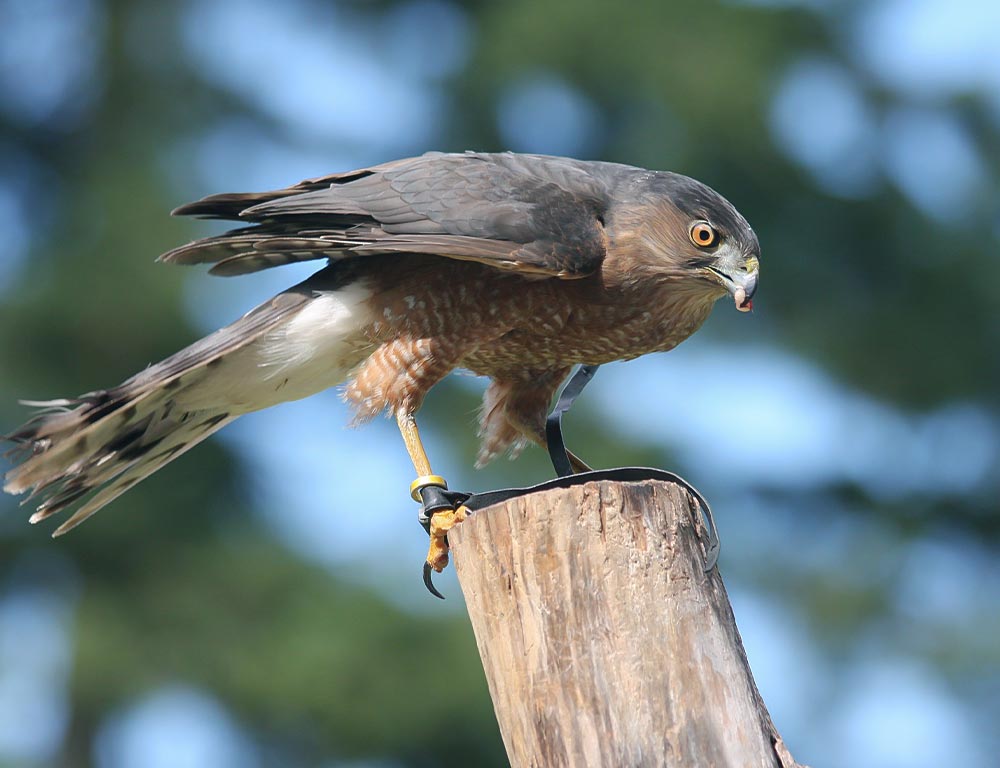
- Scientific name: Accipiter cooperii
- Population: Common year-round resident
- Life span: 7-8 years (average)
- Size: 14-20 inches
- Weight: 0.5-1.5 pounds
- Food: Birds, small mammals
- Wingspan: 24-35 inches
- Status: Secure
Cooper’s Hawks are agile woodland hunters found year-round in Texas. Recognized by their short, rounded wings and long tails, these hawks specialize in preying on birds, using their rapid flight and maneuverability to navigate through dense vegetation.
Their hunting technique often involves surprise attacks, capturing prey with their sharp talons. These hawks build nests in trees using sticks and twigs. During the breeding season, males perform acrobatic displays to attract females.
With an average lifespan of 7-8 years, Cooper’s Hawks play a crucial role in controlling bird populations, especially in urban and suburban areas. While considered a secure species, they face habitat loss and pesticide exposure threats.
Conservation efforts focus on preserving wooded habitats and raising awareness about the importance of these raptors in maintaining a balanced ecosystem.
6. Ferruginous Hawk
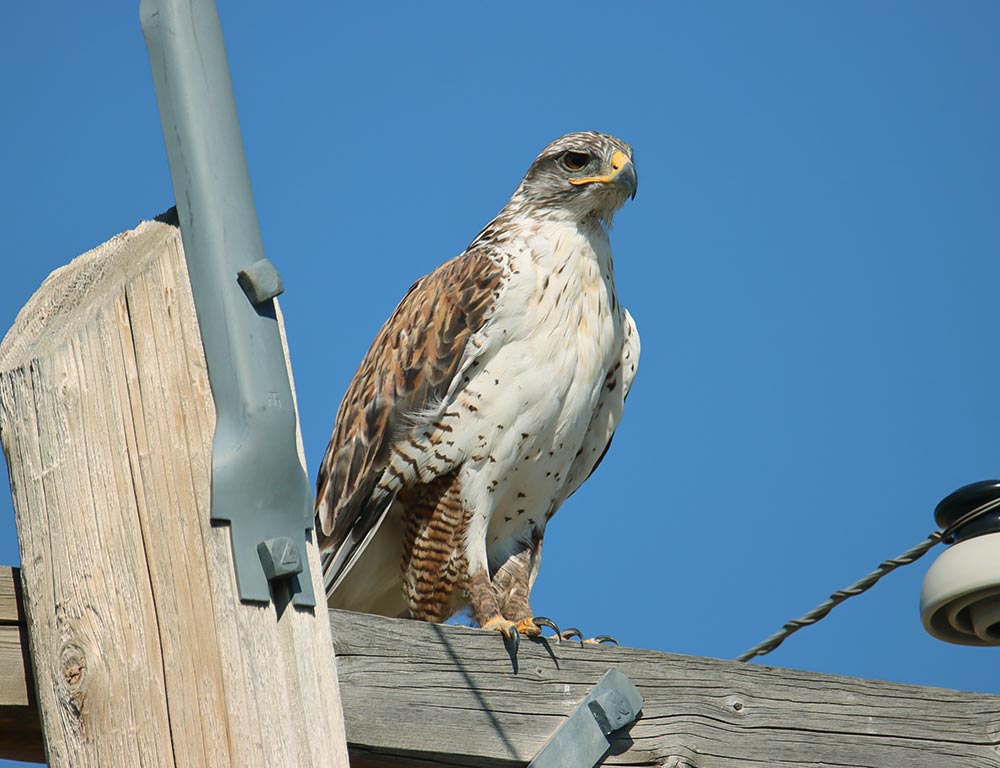
- Scientific name: Buteo regalis
- Population: Resident in western Texas, migratory in eastern Texas
- Life span: 10-15 years
- Size: 22-27 inches
- Weight: 2.5-5.5 pounds
- Food: Small mammals, ground squirrels, rabbits
- Wingspan: 52-56 inches
- Status: Near Threatened
Ferruginous Hawks are large raptors with distinctive rusty or light-colored plumage on their legs and underparts. Resident in western Texas and migratory in the eastern part of the state, these hawks prefer open grasslands and prairies.
Their diet consists mainly of small mammals, ground squirrels, and rabbits, and they are known for their habit of hunting from perches or soaring at great heights.
Breeding pairs construct nests on cliffs or on the ground, using sticks and grass. These hawks exhibit monogamous behavior during the breeding season.
With a lifespan of 10-15 years, Ferruginous Hawks are important for controlling rodent populations, contributing to the ecological balance in their habitats.
Listed as Near Threatened due to habitat loss and fragmentation, conservation efforts are crucial to protect their breeding and wintering grounds.
Initiatives focus on habitat restoration and raising awareness about the significance of preserving these open landscapes for Ferruginous Hawks and the biodiversity they support.
7. Red-tailed Hawk
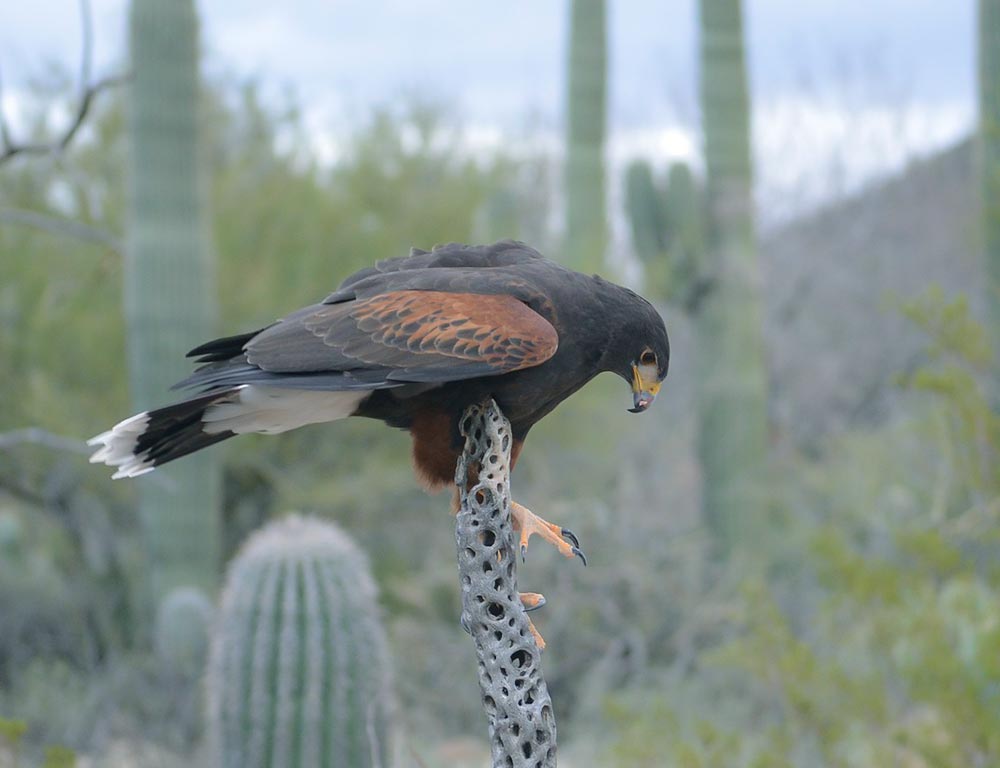
- Scientific name: Buteo jamaicensis
- Population: Abundant year-round resident
- Life span: 10-20 years
- Size: 18-26 inches
- Weight: 2-4 pounds
- Food: Varied diet including small mammals, birds, and reptiles
- Wingspan: 45-52 inches
- Status: Secure
The Red-tailed Hawk is one of Texas’s most common and widely distributed hawks.
Recognizable by their reddish-brown tails and patagial markings, they are versatile predators with a varied diet, including small mammals, birds, and reptiles.
Red-tailed Hawks are known for their soaring flight and keen eyesight, allowing them to spot prey from great distances.
Nests are typically built in trees, and these hawks exhibit territorial behavior during the breeding season. They form long-term pair bonds, and some may mate for life.
With a lifespan ranging from 10 to 20 years, Red-tailed Hawks are important for controlling rodent populations, making them valuable assets to agricultural areas.
Considered secure, Red-tailed Hawks face habitat loss threats and vehicle collisions.
Conservation efforts focus on preserving their diverse habitats, including natural and human-altered landscapes, and promoting awareness about these raptors’ critical role in maintaining ecosystem health.
8. Rough-legged Hawk
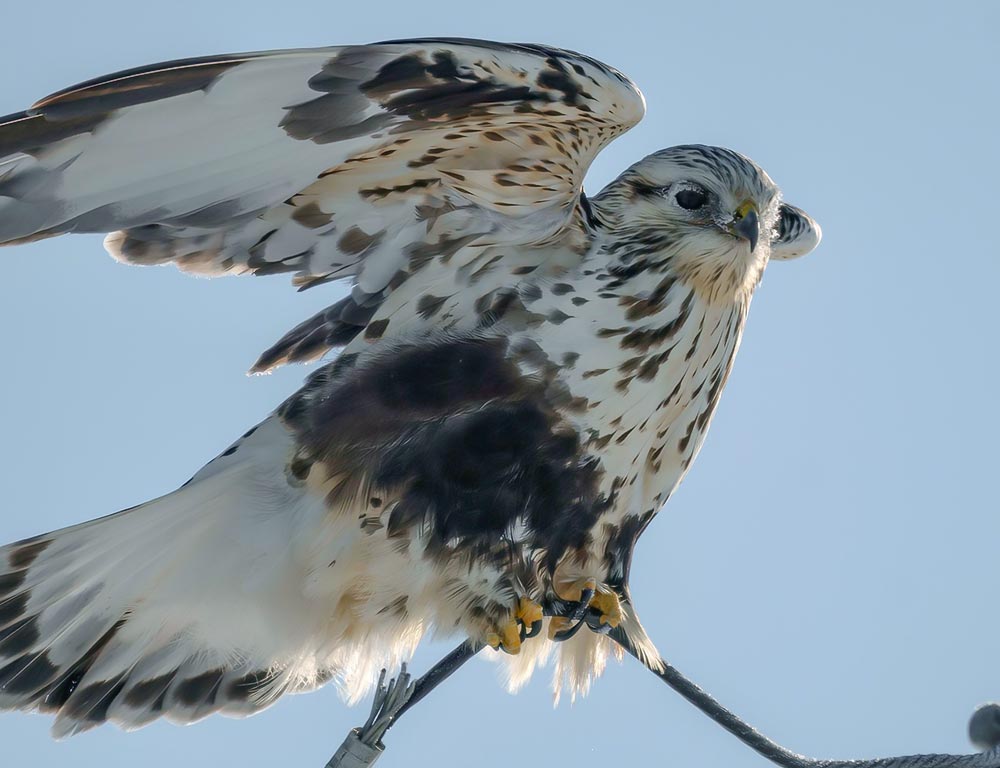
- Scientific name: Buteo lagopus
- Population: Winter visitor to Texas
- Life span: 5-10 years
- Size: 18-24 inches
- Weight: 2-4 pounds
- Food: Small mammals, especially voles
- Wingspan: 52-54 inches
- Status: Least Concern
The Rough-legged Hawk is a winter visitor to Texas, migrating south from its Arctic breeding grounds.
These hawks are recognized by their feathered legs, which extend all the way down to their toes, providing insulation against the cold. Their plumage can vary widely, ranging from light to dark morphs.
Feeding primarily on small mammals, especially voles, Rough-legged Hawks are often seen hovering over open fields before diving to catch their prey. Their long wings and tails make them well-adapted to soaring and hovering flight.
During the breeding season, Rough-legged Hawks construct nests on cliffs or elevated locations in their Arctic tundra habitats.
They are known for their nomadic lifestyle, covering large distances in search of food during the winter. With a lifespan of 5-10 years, these hawks are currently classified as Least Concern.
Conservation efforts focus on protecting their Arctic breeding grounds and ensuring the availability of suitable wintering habitats to support their populations during migration.
9. Gray Hawk
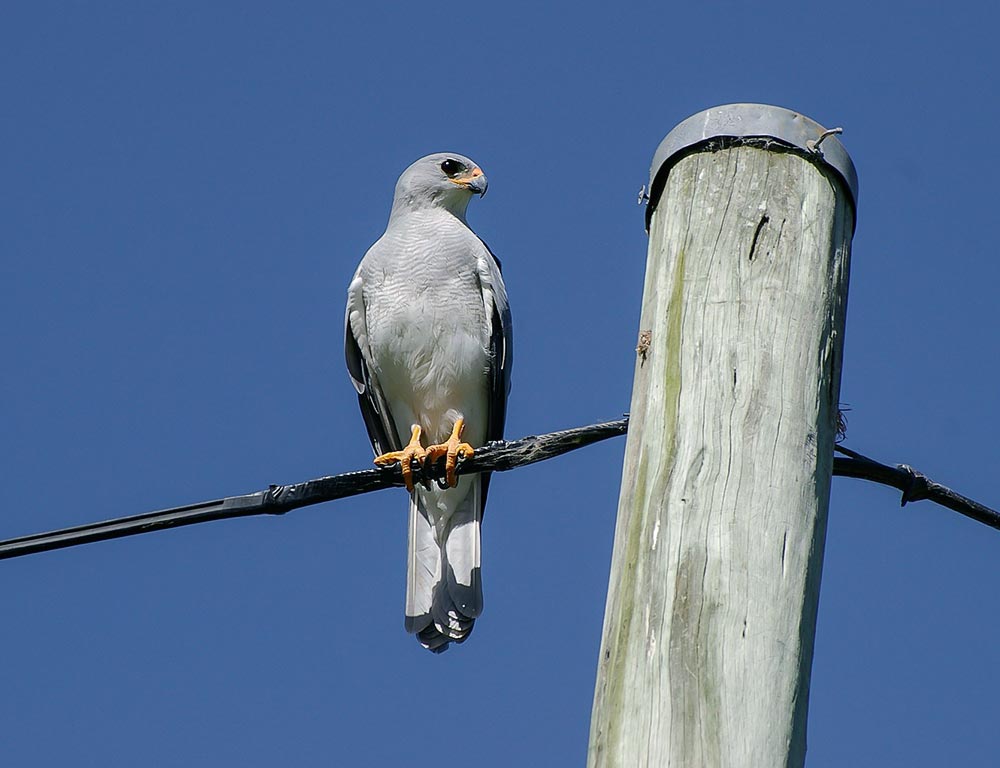
- Scientific name: Buteo nitidus
- Population: Resident in southern Texas and parts of Mexico
- Life span: 10-15 years
- Size: 16-18 inches
- Weight: 10-16 ounces
- Food: Mainly reptiles, small mammals, and insects
- Wingspan: 32-40 inches
- Status: Near Threatened
The Gray Hawk is a raptor species found in the southernmost regions of Texas and parts of Mexico.
Recognized by its slate-gray plumage, this hawk prefers riparian habitats, including riverine forests and wooded areas near water sources. Its diet consists mainly of reptiles, small mammals, and insects.
Gray Hawks construct nests in trees, usually near water, using sticks and twigs. They exhibit territorial behavior during the breeding season, often defending their nesting territories from other birds. Breeding pairs form long-term bonds and engage in elaborate courtship displays.
With a lifespan of 10-15 years, Gray Hawks face threats from habitat destruction and degradation. Conservation efforts are essential to protect their riparian habitats and ensure the availability of suitable nesting sites.
Monitoring and research are crucial to understanding their populations and implementing effective conservation strategies. Listed as Near Threatened, the Gray Hawk emphasizes the importance of preserving diverse ecosystems in southern Texas and Mexico.
10. Harris’s Hawk
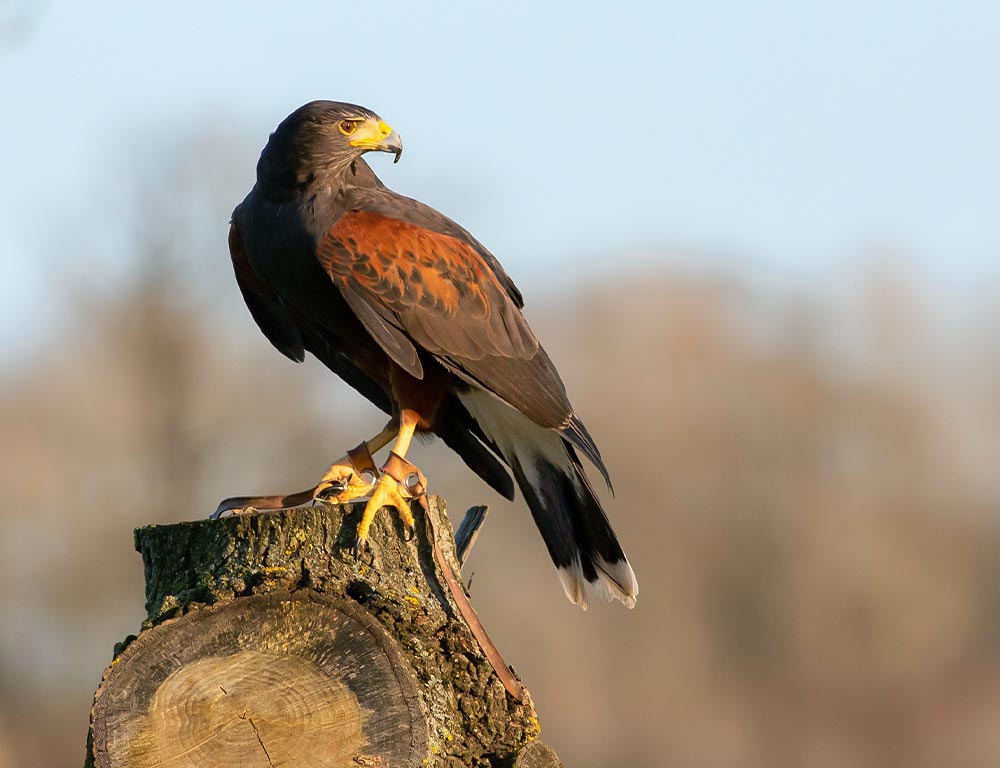
- Scientific name: Parabuteo unicinctus
- Population: Resident in Texas, southwestern U.S., and Central and South America
- Life span: 12-16 years
- Size: 18-24 inches
- Weight: 1.5-3.5 pounds
- Food: Birds, mammals, reptiles
- Wingspan: 3.3-4.4 feet
- Status: Least Concern
Harris’s Hawks are unique among raptors for their cooperative hunting behavior and social structure.
Resident in Texas, the southwestern United States, and parts of Central and South America, these hawks are recognized by their chestnut-colored plumage, white markings on their tails, and striking yellow legs.
Known for their intelligence and adaptability, Harris’s Hawks hunt in family groups, making them one of the few raptor species to do so.
Their diet includes a variety of birds, mammals, and reptiles. These hawks build nests in trees or on cliffs, and their breeding pairs exhibit strong bonds.
With a lifespan of 12-16 years, Harris’s Hawks are considered the least Concerned. Their adaptability to urban environments has contributed to their success in coexisting with human activities.
Conservation efforts focus on ensuring the availability of suitable nesting sites and maintaining the health of their diverse habitats.
11. Northern Harrier

- Scientific name: Circus hudsonius
- Population: Winter visitor to Texas
- Life span: 7 years (average)
- Size: 18-24 inches
- Weight: 10-26 ounces
- Food: Small mammals, birds, and reptiles
- Wingspan: 40-48 inches
- Status: Least Concern
The Northern Harrier, often called the “Marsh Hawk,” is a winter visitor to Texas, migrating south from its breeding grounds in northern North America.
Identified by its distinctive facial disk, these hawks are known for their low, cruising flight over marshes and open fields.
Feeding primarily on small mammals, birds, and reptiles, Northern Harriers employ a unique hunting technique known as “owl-like” hovering, where they fly low over the ground and use their keen sense of hearing to locate prey. They nest on the ground, constructing nests in tall grass or reeds.
With an average lifespan of 7 years, Northern Harriers face habitat loss and degradation threats, especially in their breeding and wintering areas.
Conservation efforts focus on preserving their critical habitats, including wetlands and grasslands, and implementing measures to mitigate the impacts of human activities on these areas.
12. Common Black Hawk
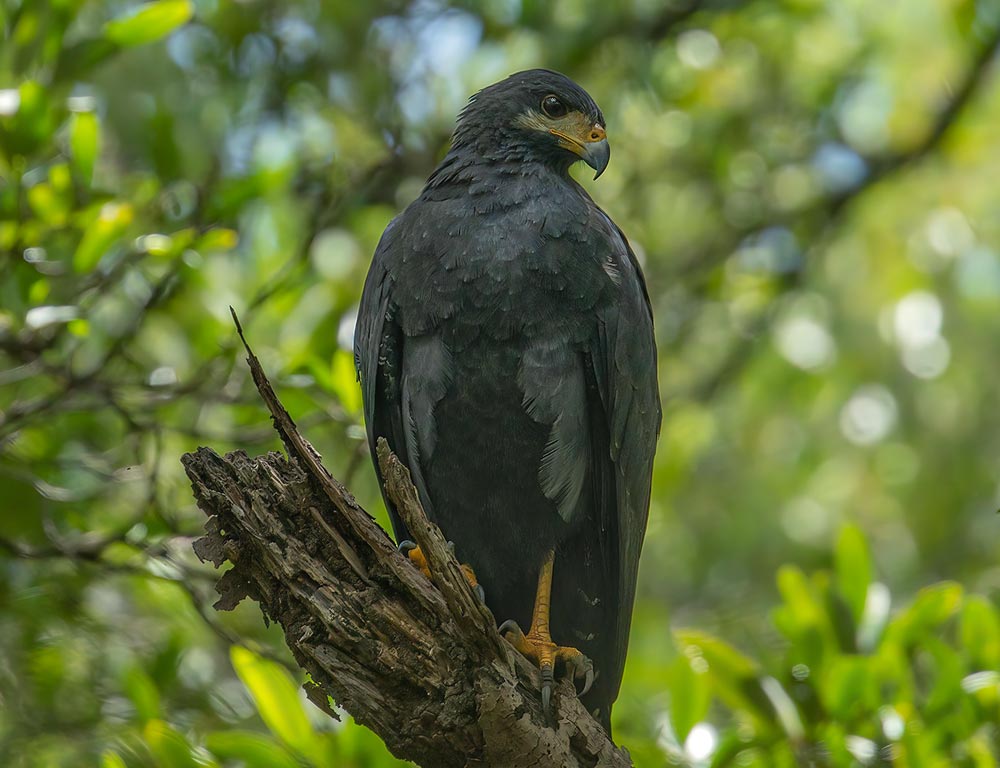
- Scientific name: Buteogallus anthracinus
- Population: Resident in southern Texas and parts of Mexico
- Life span: 15-20 years
- Size: 18-22 inches
- Weight: 2-3 pounds
- Food: Fish, small mammals, birds
- Wingspan: 3.5-4 feet
- Status: Least Concern
The Common Black Hawk is a distinctive raptor found in southern Texas and parts of Mexico, known for its black plumage, red legs, and striking yellow cere.
These hawks are often associated with riparian habitats, nesting near rivers or streams. Common Black Hawks are skilled hunters with a diet mainly consisting of fish, small mammals, and birds.
They build nests in trees, often situated near water, using sticks and twigs. Breeding pairs form strong bonds, and both members participate in nest-building and raising their young.
With a lifespan ranging from 15 to 20 years, Common Black Hawks are currently classified as Least Concern. However, they face threats from habitat destruction and disturbance.
Conservation efforts focus on protecting their riparian habitats, ensuring a sustainable supply of prey, and raising awareness about the importance of preserving these ecosystems for the Common Black Hawk and other wildlife species.
13. Northern Goshawk

- Scientific name: Accipiter gentilis
- Population: Widespread, found in various habitats in the Northern Hemisphere
- Life span: 8-15 years
- Size: 20-26 inches
- Weight: 1.5-3.5 pounds
- Food: Mainly birds, occasionally mammals
- Wingspan: 40-46 inches
- Status: Least Concern
The Northern Goshawk is a large and powerful hawk distributed across the Northern Hemisphere, inhabiting various forested environments. Recognized for its strong, robust build and short, broad wings, this raptor is an agile hunter.
Its diet primarily consists of birds, including medium-sized to large species, but it may also prey on mammals. Northern Goshawks build nests in trees, usually constructing them with sticks and lined with softer materials.
They are territorial during the breeding season, displaying impressive aerial courtship displays. These hawks are known for their adaptability to diverse habitats, ranging from coniferous and deciduous forests to mountainous regions.
While the Northern Goshawk is generally considered the least Concerned, some populations face threats from habitat loss, logging practices, and human disturbance.
Conservation efforts focus on sustainable forest management practices, protection of nesting habitats, and monitoring to ensure the well-being of these important predators.
14. Buteo albonotatus – Zone-tailed Hawk
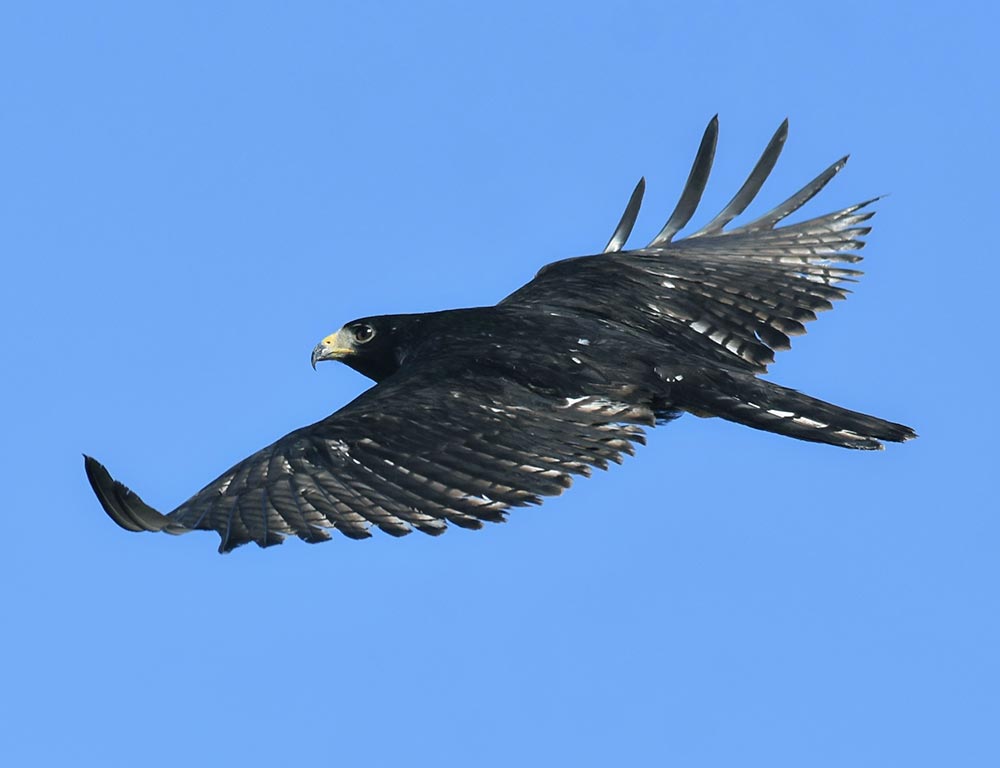
- Population: Found in the southwestern United States, Mexico, and Central America
- Life span: 10-15 years
- Size: 18-24 inches
- Weight: 1.5-2.5 pounds
- Food: Reptiles, small mammals, birds
- Wingspan: 42-46 inches
- Status: Least Concern
The Zone-tailed Hawk is a medium-sized buteo found in the southwestern United States, Mexico, and parts of Central America. It’s known for mimicking vultures in flight, possibly as a strategy to surprise prey.
This hawk primarily preys on reptiles, small mammals, and birds. Zone-tailed Hawks construct nests in trees, often choosing sites near rivers or cliffs.
They are adaptable to various habitats, including deserts and open woodlands. Breeding pairs form monogamous bonds, and both partners contribute to nest-building and raising their young.
With a lifespan of 10-15 years, Zone-tailed Hawks are classified as Least Concern. While they face habitat loss and human disturbance threats, their populations remain stable.
Conservation efforts focus on monitoring their habitats and addressing potential threats to ensure the continued health of their populations.
Wrapping Up
In our exploration of Hawks in Texas, we’ve unveiled a captivating world where 14 distinct species grace the expansive skies of the Lone Star State.
Each plays a vital role in maintaining ecological balance, from the nimble, Sharp-shinned Hawk to the iconic Red-tailed Hawk.
The diverse habitats of Texas offer a stage for these avian predators, showcasing their unique behaviors, nesting habits, and hunting prowess.
As stewards of the skies, these hawks contribute to the natural tapestry of Texas and the health of the ecosystems they inhabit.
Our journey through their lives reinforces the importance of conservation efforts, ensuring that the future holds a vibrant space for these majestic birds to soar and inspire generations to come. Best of luck.